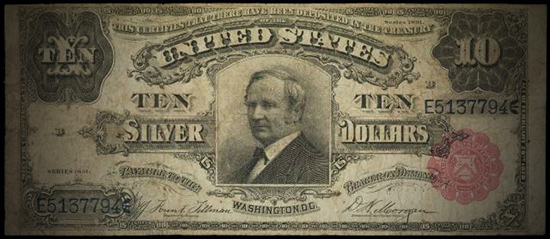Currency Spotlight: Series of 1891 Tombstone Certificate

The 1891 Tombstone note was issued in the United States between 1891 and 1907. It is a silver certificate which means that at the time of issuance it could be redeemed for a specific amount of silver. It is one of the most impressive bills to be released during America’s Silver Standard and is sought after by collectors today, especially the $10 1886 variants.
Currency Highlights
The bill features an image of Thomas Hendricks, who was the American Vice President between March and November of 1885 and Indiana governor between 1873 and 1877. He was a prominent member of the Democratic Party which at the time was fiscally conservative. He passed away a few months prior to his image appearing on the bill which leads collectors and historians to believe that it was released to honor him and the nickname “tombstone” stuck. It should be noted that contrary to what some believe, the bill was not named after the famous city of Tombstone, Arizona.
Background
The USA first switched to a monetary standard based on silver in 1785. It was initiated through the Mint and Coinage Act of 1792 and the Bank of the United States was used by the government to maintain the reserves, along with keeping a ratio between gold and the American dollar which was fixed. Although the period is called the silver standard, banks didn’t actually need to have silver on hand to back the currency. Still, both silver and gold coins were considered legal tender at the time, along with the Spanish real. The United States had amassed a considerable amount of debt because of the Revolutionary War and as a consequence silver coins which were government struck rapidly left circulation, prompting President Jefferson to suspend their mintage in 1806.
Grades And Value
Generally speaking, most 1891 $10 Certificates are not exceptionally rare. At the same time, they are not very common either, and most coin shops and currency collectors will not readily have them on hand. Therefore, this note is best for collectors who are semi-advanced. Most of its value will be determined by condition. Unlike other collectible notes, star notes were never printed for the 1891 Series although there are star notes for the 1908 Tombstones. Signature combinations come in four types, which are those signed by Tillman and Morgan, Lyons and Roberts, Bruce and Roberts or Rosecrans and Nebeker.
A $10 1891 Silver Certificate that is in pristine condition can easily fetch four figures. These bills are measured by their color, the quality of the paper and the centering. Since it wasn’t a “hoard” note at the time of issuance, you’ll have to pay and wait for a specific grade if it hasn’t already been graded, and most grading organizations are strict when it comes to giving bills a choice uncirculated rating. Notes in AU or XF condition are quite rare.


